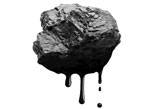Using inexpensive coal slack and the Vortex layer device, one can make fuel not inferior in terms of heat capacity to heavy fuel oil and natural gas, but a lot more economical: water-coal slurry or liquid fuel.
What is «water-coal slurry»?
Water-coal slurry (abbreviated as CWS, CWSM, CWM) is a mix of coal, water and plasticizer. Modern day CWS is coming into use in heat generation facilities as an alternative to natural gas and heavy fuel oil. The main advantage of this fuel is its cost efficiency, since the calorific value of CWS is no less than that of the more expensive natural gas and fuel oil, with a much lower cost.
Using the AVS for production of this fuel reduces production time by a factor of 3, increasing product yield by a factor of 5 or 6 compared to the use of a ball mill
The share of the fuel cost in the cost of a unit of heat produced (1 Gcal) or a unit of power produced (1 kWh), is, as a rule, the largest share and exceeds 50% of the heat unit cost. The remaining part of the cost of heat or power depends on the cost of plant equipment operation, including labot costs, rent, depreciation of buildings and fixed assets, the overhead, taxes etc. For heat and power plants running on gas, heavy fuel oil or coal the parameters have already been calculated or at least calculation methods exist. Heat and power plants running on CWS require separate calculation.
CWS is characterized by the following parameters:
- rheological (viscosity, shift tension);
- sedimentation (retaining the uniformity in static and dynamic conditions);
- combustive (fuel value, efficiency of combustion)
CWS has the following properties:
- ignition temperature – 800-850°С;
- combustion – 950-1150°С;
- calorific value – 3700-4700 kcal.
- carbon combustion ratio – above 99 %
CWS production technology
CWS consists of 55-70% finely dispersed coal, 30/48% water and plasticizer. Water in CWS reduces emissions and makes the coal safe in terms of explosion and fire hazard. The cost of coal is approximately one third of the heating oil fuel. Despite the fluctuations of the world’s coal prices, this ratio remains about the same.
The process of CWS production consists of three stages (Fig.1):
- Preliminary crushing to 3-12 mm size. This may not be necessary if coal slag with small enough particles is used.
- Wet grinding in ball mills to particle size less than 3 – 150 µm. This is the key stage, since the quality of grinding and dispersion defines the properties of CWS, such as viscosity and stability.
- At this stage, the uneven distribution of particles in the suspension is corrected, plasticizers and stabilizers are added. At this third stage, CWS receives the required homogeneous quality.

CWS production stages
Pulverization of coal is the main problem that must be solved in the process of CWS production|. Rheological properties and combustion stability depend directly on the stability of coal pulverization and the correct concentrations of the auxiliary components.
To crush coal, shale or coke breeze, hammermills or ball mills of various types are used.
Among the many existing methods of coal crushing, the continuous wet grinding ball mills are the most widely used at this time.
Coal, crushed to particle size of 3-6 mm, is fed into ball mills for further pulverization, along with water and additive. The ball mill crushes the coal to fraction size 0-3 µm. After combining all of the components, the material returns to the mill for a more thorough mixing.
GlobeCore engineers have tested AVS for coal-water fuel production, you can see our results on the video below:
Implementation of AVS-100 process intensifier
As was described in the previous articles, the vortex layer devices have several advantages over other types of equipment: sharp increase of physical and chemical process rate by several orders of magnitude; improvement of product quality; reduction of raw material consumption and increased product yield; reduction of energy costs; reduced equipment footprint etc.
The table below shows the comparative results of powder pulverization in AVS and various other types of mills.
Table 1
Results of the various equipment in the grinding process of powder
| Equpment | Power consumption, kW | Processing rate, kg/hour | 3 µm fraction output, % |
| AVS | 1,5 | > 2 | 50 |
| Ball mill (wet grinding) | 0,5 | > 1 | 7-15 |
| Ball mill (dry grinding) | 0,5 | > 2 | 1-3 |
| Centrifugal mill | 0,6 | До 10 | 5 |
| Hammer mill | 2,0 | > 80 | 5 |
As seen from the table, AVS significantly reduces the production time (by a factor of 3), increasing 5-6 times more of the product, than with a wet grinding ball mill.
It should be noted, that AVS is most beneficial in the final grinding stage. Besides, the vortex layer devices allow to product a more finely pulverized product. The devices, developed by out company not only intensify a range of processes, but also raise the general level of production, eliminating ball and vibration crushers, which are sources of increased noise and dust.

